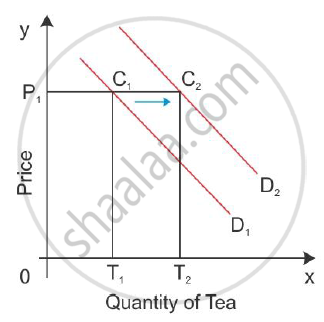Advertisements
Advertisements
प्रश्न
With the help of suitable diagram explain the meaning of rightward shift in the demand curve. Explain briefly any two of its determinants.
उत्तर
A change in demand means a shift in the demand curve. An increase in demand or a rightward shift in the demand curve is caused by a change in factors other than the price of the good. For example, if there is an increase in the price of a substitute good, say coffee, then the demand curve for tea shifts to the right. Thus, the consumer demand curve shifts from D1 to D2, consuming more of tea even when its price is constant.

Two determinants of demand:
- Increase in price of related commodity: The demand for any commodity depends on the prices of related commodities. For example, if the price of tea falls, the demand for coffee may decline because a consumer may now substitute tea for coffee.
- Increase in income of the consumer: A level of demand schedules also affects income changes. With an increase in income, a consumer will tend to buy more of any particular commodity. Hence, the demand schedule will shift to the right.
APPEARS IN
संबंधित प्रश्न
Complete the following demand schedule:
| Price (in ₹) | Quantity of mangoes demanded (in kg) |
| 350 | 2 |
| 300 | |
| 250 | |
| 200 | |
| 150 | |
| 100 |
The demand curve is generally ______.
Differentiate between individual demand schedule and market demand schedule.
Using hypothetical data show a market demand schedule.
State the impact of the following changes on the demand curve of a commodity:
increase in individual income
State the impact of the following changes on the demand curve of a commodity:
Increase in the supply of a substitute commodity
State the impact of the following changes on the demand curve of a commodity:
Increase in the price of a complementary commodity
With the help of a hypothetical table, draw the demand curve of a commodity.
How is the market demand curve derived from the individual demand curves?
Define a market demand schedule.
